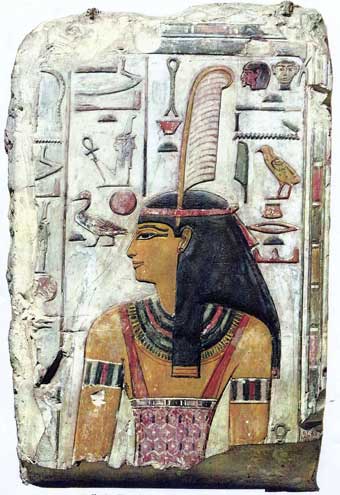Great is Maat
Her Cyclopedia: The Goddess Maat
return to Home Page
or move on to Goddess Mahavidya, next chronologically,
or use Her Cyclopedia Index
Maat, Truth.
M1*T
Alternate meanings: Justice, Law.
[to Whom the twenty-seventh day of September, day 270, is dedicated]

Geography/Culture: Egyptian.
Linguistic Note: the fundamental idea of the word is 'straight', and from the Egyptian texts it is clear that it meant 'right, true, truth, real, genuine, upright, righteous, just, steadfast, unalterable', etc.
Description: Maat the beautiful; Maat the everlasting and never-changing; Goddess of the heart's law, divinely ordered justice, equity, wisdom and reality; Personification of kindness, fairness and consideration; Guardian of the rhythm and order of the cosmos; Emanation of the sun; Regulator of the sun's path; Lady of Heaven; the Eye which sees all; Spirit of world law and order; Balancer of opposites; Queen of earth; Mistress of the Underworld; She Who listens to the confessions of the dead and announces judgement; She Whose concern is for justice and truth; She Who is the food and drink of the Deities; She Who is straight, right, true, truth, real, genuine, righteous, steadfast, and unalterable.
Invocations, Pleas, Hymns and Other Homage to HER: Maat.
To Whom Sacred: the maat plant (corn, wheat); bull; ostrich feather, the hieroglyph phonetic value which is Her name (symbol of the breath of life -- the heart of the deceased should exactly balance the feather in the Great Balance: true action and speech make one 'light of heart'); {perhaps} ostrich egg; ankh (symbol of life); {perhaps} workman's measuring reed; judges (who are Her priests); morning-star; evening-star; scales (of justice in which the heart is weighed against the plume of justice); the solar barque called maatet.
Iconography: as a woman standing in the solar barque; seated on a throne in Hall of Maati; She wears a ostrich feather on Her head, or the ostrich feather replaces Her head; She sometimes holds the sceptre and the ankh; as the maat, a pedestal symbolizing the divine order (on which deities and pharaohs are sometimes represented sitting or standing).
Male Associates: consort, Thoth, God of wisdom and the moon; twin brother: Shu.
Titles/Variants, etc:
- Associated with Her is: Am-Mit, Eater-of-the-Dead, below.
- Language or transcription variant:
Maa.
- Dual form: Maati, {Justices}, below.
- Language or transcription variant:
Maet.
- Language or transcription variant:
Maht.
- Also called Mayet, ----, below.
- Daughter of Naunet, ----, Who is linked with Heket, Great-Magician.
- Tefnut, Dew-of-Dawn, is sometimes identified with Her.
Source: Budge EAWB 42, 118, 185, 236, 199, 236, 315, 340, 349, 403, 488; Ions EM 13, 25, 28, 40, 77, 103, 112-3, 124, 135, 136; Lurker GSAE 78.
Am-Mit, Eater-of-the-Dead.
*M-MYT
Geography/Culture: Egyptian.
Description: She Who devours the hearts of the guilty after judgement in the Hall of Maati.
Iconography: She has the body of a lion, the hind-quarters of a hippotamus and the forepart of a crocodile; She often crouches at the side of the scales where the heart is weighed, or at the feet of Maat, Truth.
Titles/Variants, etc:
- She is also called:
Amam, 1M1M, Devourer.
- Perhaps variant:
Ammut.
- The Sphinx, Throttler, bears some resemblances to Her appearance.
Maati, {Justices}.
M*TE
Alternate meanings: Truth, Double-Justice, Two-Truths.
Geography/Culture: Egyptian.
Description: Dual Goddess of the South and the North, Upper and Lower, Fertile valley and Barren desert; Those Who preside at the soul's judgement.
To Whom Sacred: the Hall of Maati (in which the judgement of the soul at death takes place).
Titles/Variants, etc:
- Isis, Lap-of-Power, is sometimes presented as One of the Maati, Justices.
- Transliteration variant:
Maaty.
- When Isis, Lap-of-Power, is presented as One, Nebthet, Mistress-of-the-Palace, is the Other Maati Goddess.
Mayet, ----.
M*Y]T
Geography/Culture: Egyptian.
Linguistic Note: Her name maybe a transcription, or perhaps a language variant of Maat. The fact that Tefnut, Who is sometimes identified with Maat, is also sometimes called Mayet, emphasizes the possibility.
Titles/Variants, etc:
- Maat, Truth, (above), is also called Mayet, ----.
- Tefnut, Dew-of-Dawn, is also called Mayet, ----.
worked on: September, June 1995; August 1991; July 1990.
Return to the top of this document.
